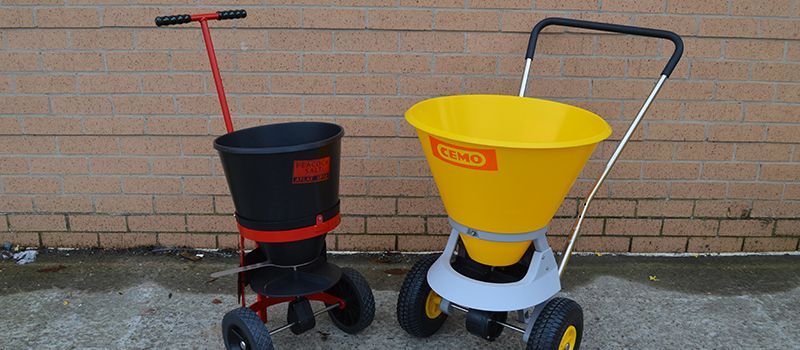Spreading salt isn’t the most glamorous of tasks, but it is important. In most cases, it is a legal requirement for business owners to properly grit their land. It can also help you avoid any expensive injury claims if you ensure your business is properly maintained over the cold winter months.
Let's look at the key facts about salt spreaders, the different types, and why they are so important to a business.
What is a salt spreader?
Salt spreaders do what they say on the tin, spread salt. Maybe we’re over simplifying it there, but their main function is to spread salt evenly and quickly to reduce the opportunity snow has to bond to the ground and form ice that will wreak havoc across the UK.
As we will discuss further, salt spreaders come in all shapes and sizes, from manual spreaders to spreaders you can put on the back of your car or van.
How does a salt spreader work?
To start with, you need to fill the hopper with salt that will be spread across the road. Once this is done, you are ready to hit the road (or the pavement!) The spinner is controlled from inside the vehicle and is used to evenly distribute salt across the road. The auger on the salt spreader pulls the salt from the hopper towards the sprayer that distributes salt.
The main aim when using a salt spreader is to reduce the likelihood of ice forming on a surface. As you can imagine, salt spreaders aren’t much use if snow is on the road already. If snow has already started to settle, then you will need to use a plough to remove snow and then spread salt, with the hope of reducing ice.
Different types of salt spreaders
The first decision you need to make is whether you need a manual salt spreader or a towable gritter.
1. Manual spreading
Designed to make gritting small to medium areas easier, quicker and more efficiently. They are simple to use as all you need to do is push them from behind. These are ideal for use in car parks, footpaths or driveways.
2. Towable gritters
These are ideal for use on larger areas or when using a manual gritter is simply too inefficient and too dangerous. These can be attached to a variety of vehicles such as cars, vans or quad bikes. Towable gritters will be able to operate when driving at a speed of 20mph.
A towable gritter is ideal for use in larger areas and is often bought by hospitals or colleges/universities.
Next up is what method of spreading you want. This is split into broadcast and drop spreading. When deciding on this part, you need to consider the size of the area you are covering and the risk if ice prevails.
3. Broadcast spreading
This is ideal for spreading salt over a larger area, it will spread a thin and consistent layer. The process of spreading the salt will be quick and relatively straightforward. The user of the spreader can control the spread of the grit through a setting on the machine. The speed you move will also dictate the area you cover.
You will commonly find this type of spreading done on roads and large car parks to prevent ice forming.
4. Drop spreading
Drop spreading will provide you with an accurate and consistent flow of grit over a defined area width. This type of spreading is ideal for covering a specific area with a larger volume of salt.
This type of salt spreading is often done by business to prevent ice forming on parts of their land. Business owners can spread lots of salt in one area to keep their land clear of ice and prevent injury to staff or customers.
Benefits of having a salt spreader
Using a salt spreader rather than spreading by using a bucket and your own hands has several benefits.
- Save time using a salt spreader rather than manually spreading salt
- Salt spreader can be used to spread other materials all year round, such as seeds for a farm land or food for farm animals
- Save money as you will use less salt compared to spreading salt by hand
- Spread salt more evenly and reduce the likelihood of ice forming
How to choose the right salt spreader for your needs
When it comes to choosing the right salt spreader for your needs, it is important to consider a few things.
Firstly, and probably most importantly, the size of the area that is going to be worked on. If you are working on a larger area of ground, you will be best off getting a towable spreader, as this will ensure the job is done quicker and to acceptable standards.
The next thing to consider goes hand in hand with the above. You will need to consider the capacity of the salt spreader you purchase. If you don’t get the right capacity, you will be stuck refilling your spreader halfway through.
Another thing to consider is the durability of the salt spreader. If you are going to use the spreader quite a lot over a large area of land, you don’t want to have to keep buying a new salt spreader every other month because the one you have can’t handle the heavy-duty use. You need to make sure the salt spreader will give you value for money and be up to the task at hand.
As the weather begins to get colder across the UK, it is time to prepare your home or business for all types of weather, and we hope this salt spreader guide helps you do just that.
If you’d like to find out more about the salt spreaders we have available, please contact our sales team on 01777 858009 or email sales@kingfisherdirect.co.uk.






